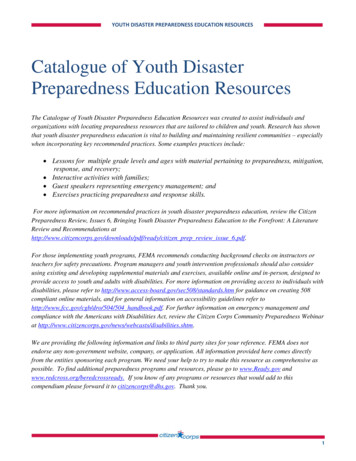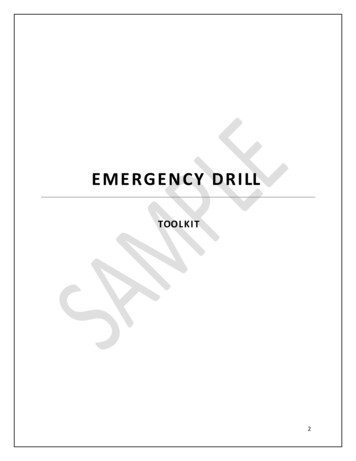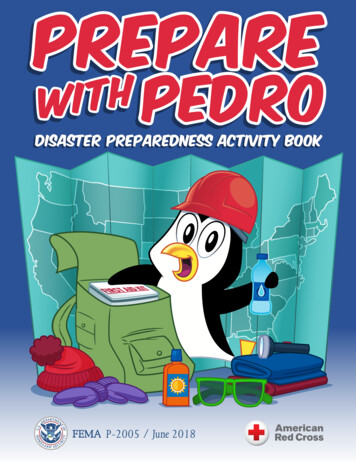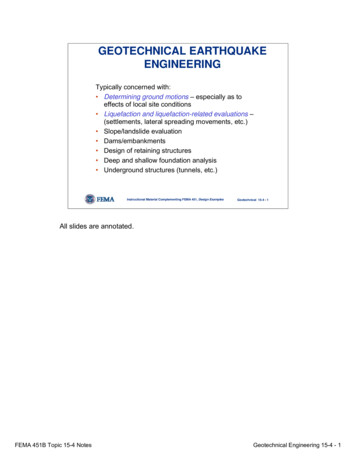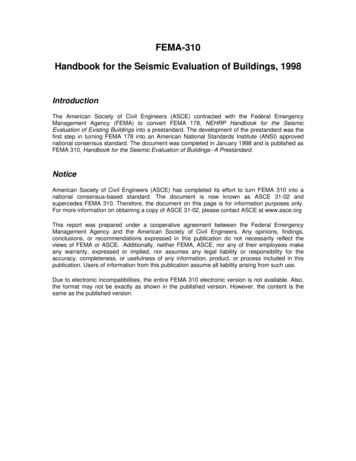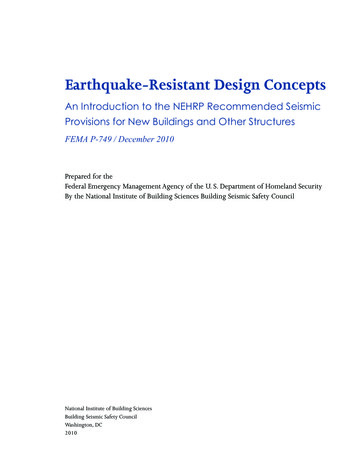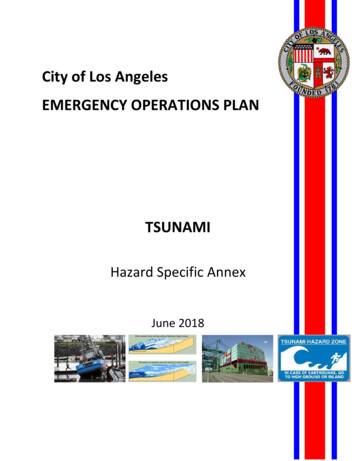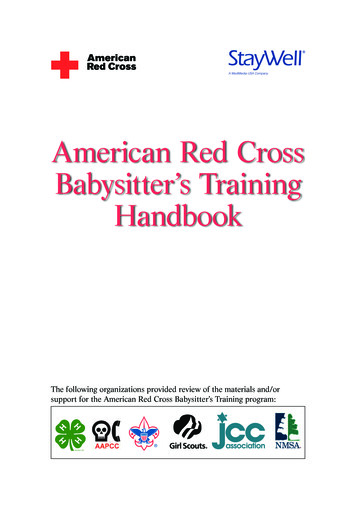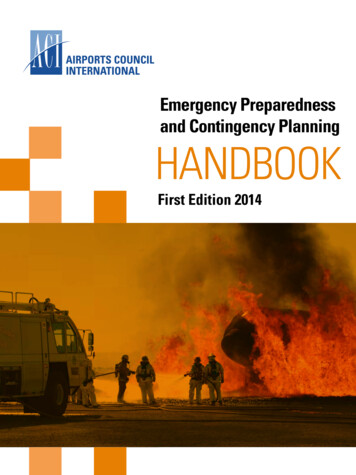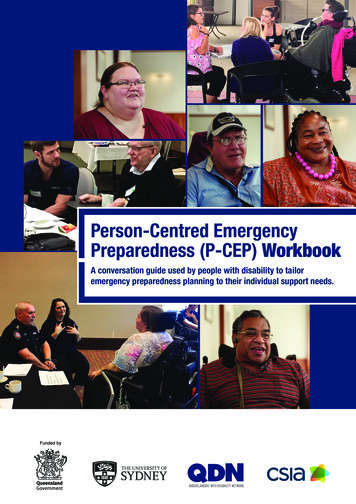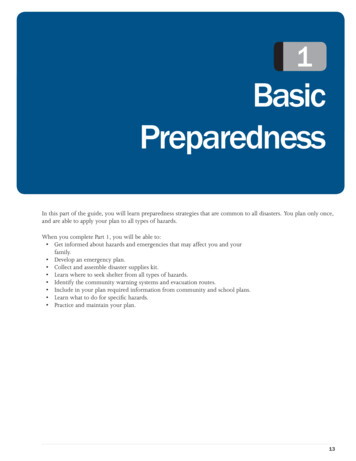
Transcription
1BasicPreparednessIn this part of the guide, you will learn preparedness strategies that are common to all disasters. You plan only once,and are able to apply your plan to all types of hazards.When you complete Part 1, you will be able to: Get informed about hazards and emergencies that may affect you and yourfamily. Develop an emergency plan. Collect and assemble disaster supplies kit. Learn where to seek shelter from all types of hazards. Identify the community warning systems and evacuation routes. Include in your plan required information from community and school plans. Learn what to do for specific hazards. Practice and maintain your plan.13
14
1.1Getting Informed15
1.1Getting InformedAre You Ready?Learn about the hazards that may strike your community, the risks you face fromthese hazards, and your community’s plans for warning and evacuation. You canobtain this information from your local emergency management office or yourlocal chapter of the American Red Cross. Space has been provided here to recordyour answers.HazardsAsk local authorities about each possible hazard or emergency and use the worksheet that follows to record your findings and suggestions for reducing yourfamily’s risk.Possible Hazards andEmergenciesNatural Hazards1. Floods2. Hurricanes3. Thunderstorms andLightning4. Tornadoes5. Winter Storms andExtreme Cold6. Extreme Heat7. Earthquakes8. Volcanoes9. Landslides and DebrisFlow10. Tsunamis11. Fires12. Wildfires16Risk Level(None, Low,Moderate, orHigh)How can I reduce my risk?
Are You Ready?Getting Informed1.1Technological HazardsBasicPreparedness1. Hazardous MaterialsIncidents2. Nuclear Power PlantsTerrorism1. Explosions2. Biological Threats3. Chemical Threats4. Nuclear Blasts5. Radiological DispersionDevice (RDD)You also can consult FEMA for hazard maps for your area. Go towww.fema.gov, select maps, and follow the directions. National hazard maps have been included with each natural hazard in Part 2 of thisguide.17
1.1Getting InformedAre You Ready?Warning Systems and SignalsThe Emergency Alert System (EAS) can address the entire nation on very short notice in case of a grave threat or national emergency. Ask if your local radio and TVstations participate in the EAS.National Oceanic & Atmospheric Administration (NOAA) Weather Radio (NWR) isa nationwide network of radio stations broadcasting continuous weather information directly from a nearby National Weather Service office to specially configuredNOAA weather radio receivers. Determine if NOAA Weather Radio is availablewhere you live. If so, consider purchasing a NOAA weather radio receiver.Ask local authorities about methods used to warn your community.Warning SystemEASNOAA Weather Radio18What should we do?
Are You Ready?Getting Informed1.1BasicPreparednessEvacuating Yourself andYour FamilyWhen community evacuations become necessary, local officials provide information to the public through the media. In some circumstances, other warningmethods, such as sirens or telephone calls, also are used. Additionally, there maybe circumstances under which you and your family feel threatened or endangeredand you need to leave your home, school, or workplace to avoid these situations.The amount of time you have to leave will depend on the hazard. If the event isa weather condition, such as a hurricane that can be monitored, you might havea day or two to get ready. However, many disasters allow no time for people togather even the most basic necessities, which is why planning ahead is essential.Evacuation: More Common than You RealizeEvacuations are more common than many people realize. Hundreds oftimes each year, transportation and industrial accidents release harmfulsubstances, forcing thousands of people to leave their homes. Fires andfloods cause evacuations even more frequently. Almost every year, peoplealong the Gulf and Atlantic coasts evacuate in the face of approachinghurricanes.Ask local authorities about emergency evacuation routes.Record your specific evacuation route directions in the space provided.Is there a map available with evacuation routes marked?YesNo19
1.1Evacuation GuidelinesGetting InformedAlways:If time permits:Keep a full tank of gas in your car if anevacuation seems likely. Gas stations maybe closed during emergencies and unableto pump gas during power outages. Plan totake one car per family to reduce congestionand delay.Make transportation arrangements withfriends or your local government if you donot own a car.Gather your disaster supplies kit.Listen to a battery-powered radio and followlocal evacuation instructions.Gather your family and go if you are instructed to evacuate immediately.Leave early enough to avoid being trapped bysevere weather.Follow recommended evacuation routes. Donot take shortcuts; they may be blocked.Be alert for washed-out roads and bridges.Do not drive into flooded areas.Stay away from downed power lines.20Are You Ready?Wear sturdy shoes and clothingthat provides some protection,such as long pants, long-sleevedshirts, and a cap.Secure your home: Close and lock doors andwindows. Unplug electrical equipment,such as radios and televisions, and small appliances,such as toasters and microwaves. Leave freezers and refrigerators plugged in unlessthere is a risk of flooding.Let others know where you aregoing.
Getting InformedAre You Ready?1.1BasicPreparednessCommunity and Other PlansAsk local officials the following questions about your community’s disaster/emergency plans.emergeDoes my community have a plan?YesNoCan I obtain a copy?YesNoWhat does the plan contain?How often is it updated?What should I know about the plan?What hazards does it cover?In addition to finding out about your community’s plan, it is important that youknow what plans are in place for your workplace and your children’s school or daycare center.1. Ask your employer about workplace policies regarding disasters and emergencies, including understanding how you will be provided emergency andwarning information.2. Contact your children’s school or day care center to discuss their disaster procedures.School Emergency PlansKnow your children’s school emergency plan: Ask how the school will communicate with families during a crisis. Ask if the school stores adequate food, water, and other basic supplies. Find out if the school is prepared to shelter-in-place if need be, and wherethey plan to go if they must get away.In cases where schools institute procedures to shelter-in-place, you may not bepermitted to drive to the school to pick up your children. Even if you go to theschool, the doors will likely be locked to keep your children safe. Monitor localmedia outlets for announcements about changes in school openings and closings,and follow the directions of local emergency officials.For more information on developing emergency preparedness plans for schools,please log on to the U.S. Department of Education at www.ed.gov/emergencyplan.21
1.1Getting InformedWorkplace PlansIf you are an employer, make sure your workplace has a building evacuation planthat is regularly practiced. Take a critical look at your heating, ventilation and air conditioning systemto determine if it is secure or if it could feasibly be upgraded to better filterpotential contaminants, and be sure you know how to turn it off if you needto. Think about what to do if your employees can’t go home. Make sure you have appropriate supplies on hand.22Are You Ready?
1.2Emergency Planningand Checklists
1.2Emergency Planning and ChecklistsAre You Ready?Now that you’ve learned about what can happen and how your community is prepared to respond to emergencies, prepare your family by creating a family disasterplan. You can begin this process by gathering family members and reviewing theinformation you obtained in Section 1.1 (hazards, warning systems, evacuationroutes and community and other plans). Discuss with them what you would do iffamily members are not home when a warning is issued. Additionally, your familyplan should address the following: Escape routes.Family communications.Utility shut-off and safety.Insurance and vital records.Special needs.Caring for animals.Saftey SkillsInformation on these family planning considerations are covered in the followingsections.Escape RoutesDraw a floor plan of your home. Use a blank sheet of paper for each floor. Marktwo escape routes from each room. Make sure children understand the drawings.Post a copy of the drawings at eye level in each child’s room.Where to MeetEstablish a place to meet in the event of an emergency, such as a fire. Record thelocations below:Where to meet 24Near thehomeFor example, the next door neighbor’s telephone poleOutside theimmediateareaFor example, the neighborhood grocery store parking lot
Are You Ready?Emergency Planning and Checklists1.2BasicPreparednessFamily CommunicationsYour family may not be together when disaster strikes, so plan how you will contact one another. Think about how you will communicate in different situations.Complete a contact card for each family member. Have family members keep thesecards handy in a wallet, purse, backpack, etc. You may want to send one to schoolwith each child to keep on file. Pick a friend or relative who lives out-of-state forhousehold members to notify they are safe.Below is a sample contact card. Copies to fill out can be found in Appendix C.Also in Appendix C is a more detailed Family Communications Plan which shouldbe completed and posted so the contact information is readily accessible to all family members. A copy should also be included in your family disaster supplies kit.Utility Shut-off and SafetyIn the event of a disaster, you may be instructed to shut off the utility service atyour home.Below is some general guidance for shutting off utility service:Modify the information provided to reflect your shut off requirements as directed by your utility company(ies).25
1.2Natural GasEmergency Planning and ChecklistsAre You Ready?Natural gas leaks and explosions are responsible for a significant number of firesfollowing disasters. It is vital that all household members know how to shut offnatural gas.Because there are different gas shut-off procedures for different gas meter configurations, it is important to contact your local gas company for guidance on preparation and response regarding gas appliances and gas service to your home.When you learn the proper shut-off procedure for your meter, share the information with everyone in your household. Be sure not to actually turn off the gaswhen practicing the proper gas shut-off procedure.If you smell gas or hear a blowing or hissing noise, open a window and get everyone out quickly. Turn off the gas, using the outside main valve if you can, and callthe gas company from a neighbor’s home.CAUTION – If you turn off the gas for any reason, a qualifiedprofessional must turn it back on. NEVER attempt to turn thegas back on yourself.WaterWater quickly becomes a precious resource following many disasters. It is vital thatall household members learn how to shut off the water at the main house valve. Cracked lines may pollute the water supply to your house. It is wise to shutoff your water until you hear from authorities that it is safe for drinking. The effects of gravity may drain the water in your hot water heater and toilettanks unless you trap it in your house by shutting off the main house valve(not the street valve in the cement box at the curb—this valve is extremelydifficult to turn and requires a special tool).Preparing to Shut Off Water Locate the shut-off valve for the water line that enters your house. It maylook like this: Make sure this valve can be completely shut off. Your valve may be rustedopen, or it may only partially close. Replace it if necessary.26
Are You Ready?Emergency Planning and Checklists1.2Electrical sparks have the potential of igniting natural gas if it is leaking. It is wiseto teach all responsible household members where and how to shut off the electricity.ElectricityPreparing to Shut Off Electricity Locate your electricity circuit box. Teach all responsible household members how to shut off the electricity tothe entire house.FOR YOUR SAFETY: Always shut off all the individualcircuits before shutting off the main circuit breaker.Insurance and Vital RecordsObtain property, health, and life insurance if you do not have them. Review existing policies for the amount and extent of coverage to ensure that what you have inplace is what is required for you and your family for all possible hazards.Flood InsuranceIf you live in a flood-prone area, consider purchasing flood insurance to reduce your risk of flood loss. Buying flood insurance tocover the value of a building and its contents will not only providegreater peace of mind, but will speed the recovery if a flood occurs.You can call 1(888)FLOOD29 to learn more about flood insurance.27BasicPreparedness Label this valve with a tag for easy identification, and make sure all householdmembers know where it is located.
1.2Emergency Planning and ChecklistsAre You Ready?Inventory Home Possessions Make a record of your personal property, for insurance purposes. Take photos or avideo of the interior and exterior of your home. Include personal belongings inyour inventory.You may also want to download the free Household and Personal Property Inventory Book from the University of Illinois at www.ag.uiuc.edu/ vista/abstracts/ahouseinv.html to help you record your possessions.Important DocumentsStore important documents such as insurance policies, deeds, property records,and other important papers in a safe place, such as a safety deposit box away fromyour home. Make copies of important documents for your disaster supplies kit.(Information about the disaster supplies kit is covered later.)MoneyConsider saving money in an emergency savings account that could be used in anycrisis. It is advisable to keep a small amount of cash or traveler’s checks at home ina safe place where you can quickly access them in case of evacuation.Special NeedsIf you or someone close to you has a disability or a special need, you may have totake additional steps to protect yourself and your family in an emergency.Planning for Special NeedsDisability/SpecialNeedAdditional StepsHearing impairedMay need to make special arrangements to receivewarnings.Mobility impairedMay need special assistance to get to a shelter.Single workingparentMay need help to plan for disasters and emergencies.Non-Englishspeaking personsMay need assistance planning for and responding toemergencies. Community and cultural groups may beable to help keep people informed.People withoutvehiclesMay need to make arrangements for transportation.People with specialdietary needsShould take special precautions to have an adequateemergency food supply.If you have special needs: Find out about special assistance that may be available in your community.Register with the office of emergency services or the local fire department forassistance so needed help can be provided.28
Are You Ready?Emergency Planning and Checklists1.2BasicPreparedness Create a network of neighbors, relatives, friends, and coworkers to aid youin an emergency. Discuss your needs and make sure everyone knows how tooperate necessary equipment. Discuss your needs with your employer. If you are mobility impaired and live or work in a high-rise building, have anescape chair. If you live in an apartment building, ask the management to mark accessibleexits clearly and to make arrangements to help you leave the building. Keep specialized items ready, including extra wheelchair batteries, oxygen,catheters, medication, food for service animals, and any other items youmight need. Be sure to make provisions for medications that require refrigeration. Keep a list of the type and model numbers of the medical devices you require.Caring for AnimalsAnimals also are affected by disasters. Use the guidelines below to prepare a planfor caring for pets and large animals.Plan for pet disaster needs by:Guidelines for Pets Identifying shelter. Gathering pet supplies. Ensuring your pet has proper ID and up-to-date veterinarian records. Providing a pet carrier and leash.Take the following steps to prepare to shelter your pet: Call your local emergency management office, animal shelter, or animal control office to get advice and information. Keep veterinary records to prove vaccinations are current. Find out which local hotels and motels allow pets and where pet boardingfacilities are located. Be sure to research some outside your local area in caselocal facilities close. Know that, with the exception of service animals, pets are not typically permitted in emergency shelters as they may affect the health and safety of otheroccupants.29
1.2Emergency Planning and ChecklistsAre You Ready?Guidelines for Large Animals If you have large animals such as horses, cattle, sheep, goats, or pigs on your property, be sure to prepare before a disaster.Use the following guidelines:1. Ensure all animals have some form of identification.2. Evacuate animals whenever possible. Map out primary and secondary routesin advance.3. Make available vehicles and trailers needed for transporting and supportingeach type of animal. Also make available experienced handlers and drivers.Note: It is best to allow animals a chance to become accustomed to vehiculartravel so they are less frightened and easier to move.4. Ensure destinations have food, water, veterinary care, and handling equipment.5. If evacuation is not possible, animal owners must decide whether to movelarge animals to shelter or turn them outside.Safety SkillsIt is important that family members know how to administer first aid and CPR andhow to use a fire extinguisher.Learn First Aid and CPRLearn How to Use a FireExtinguisher30Take a first aid and CPR class. Local American Red Cross chapters can provideinformation about this type of training. Official certification by the American RedCross provides, under the “good Samaritan” law, protection for those giving firstaid.Be sure everyone knows how to use your fire extinguisher(s) and where it is kept.You should have, at a minimum, an ABC type.
1.3Assemble a DisasterSupplies Kit
1.3Assemble a Disaster Supplies KitAre You Ready?You may need to survive on your own after a disaster. This means having yourown food, water, and other supplies in sufficient quantity to last for at least threedays. Local officials and relief workers will be on the scene after a disaster, but theycannot reach everyone immediately. You could get help in hours, or it might takedays.Basic services such as electricity, gas, water, sewage treatment, and telephones maybe cut off for days, or even a week or longer. Or, you may have to evacuate at amoment’s notice and take essentials with you. You probably will not have the opportunity to shop or search for the supplies you need.A disaster supplies kit is a collection of basic items that members of a householdmay need in the event of a disaster.Kit LocationsSince you do not know where you will be when an emergency occurs, preparesupplies for home, work, and vehicles.HomeWorkCarYour disaster supplieskit should containessential food, water,and supplies for at leastthree days.This kit should be inone container, andready to “grab and go”in case you are evacuated from your workplace.In case you are stranded, keep a kit of emergency supplies in yourcar.Keep this kit in a designated place and have itready in case you haveto leave your homequickly. Make sure allfamily members knowwhere the kit is kept.Additionally, you maywant to consider havingsupplies for shelteringfor up to two weeks.32Make sure you havefood and water in thekit. Also, be sure tohave comfortable walking shoes at your workplace in case an evacuation requires walkinglong distances.This kit should containfood, water, first aidsupplies, flares, jumpercables, and seasonalsupplies.
Are You Ready?Assemble a Disaster Supplies Kit1.3You should store at least one gallon of water per person per day. A normally activeperson needs at least one-half gallon of water daily just for drinking.How Much Water do I Need?Additionally, in determining adequate quantities, take the following into account: Individual needs vary, depending on age, physical condition, activity, diet, andclimate. Children, nursing mothers, and ill people need more water. Very hot temperatures can double the amount of water needed. A medical emergency might require additional water.To prepare safest and most reliable emergency supply of water, it is recommendedyou purchase commercially bottled water. Keep bottled water in its original container and do not open it until you need to use it.How Should I Store Water?Observe the expiration or “use by” date.It is recommended you purchase food-grade water storage containers from surplus or camping supplies stores to use for water storage. Before filling with water,thoroughly clean the containers with dishwashing soap and water, and rinse completely so there is no residual soap. Follow directions below on filling the containerwith water.If you are preparing your owncontainers of waterIf you choose to use your own storage containers, choose two-liter plastic softdrink bottles – not plastic jugs or cardboard containers that have had milk or fruitjuice in them. Milk protein and fruit sugars cannot be adequately removed fromthese containers and provide an environment for bacterial growth when wateris stored in them. Cardboard containers also leak easily and are not designed forlong-term storage of liquids. Also, do not use glass containers, because they canbreak and are heavy.Thoroughly clean the bottles with dishwashing soap and water, and rinse completely so there is no residual soap.If storing water in plastic sodabottles, follow these stepsSanitize the bottles by adding a solution of 1 teaspoon of non-scented liquidhousehold chlorine bleach to a quart of water. Swish the sanitizing solution in thebottle so that it touches all surfaces. After sanitizing the bottle, thoroughly rinse outthe sanitizing solution with clean water.Filling water containers33BasicPreparednessWater
1.3Assemble a Disaster Supplies KitAre You Ready?Fill the bottle to the top with regular tap water. If the tap water has been commercially treated from a water utility with chlorine, you do not need to add anythingelse to the water to keep it clean. If the water you are using comes from a well orwater source that is not treated with chlorine, add two drops of non-scented liquidhousehold chlorine bleach to the water.Tightly close the container using the original cap. Be careful not to contaminate thecap by touching the inside of it with your finger. Place a date on the outside of thecontainer so that you know when you filled it. Store in a cool, dark place.Replace the water every six months if not using commercially bottled water.FoodThe following are things to consider when putting together your food supplies: Avoid foods that will make you thirsty. Choose salt-free crackers, whole graincereals, and canned foods with high liquid content. Stock canned foods, dry mixes, and other staples that do not require refrigeration, cooking, water, or special preparation. You may already have many ofthese on hand. Note: Be sure to include a manual can opener. Include special dietary needs.34
Assemble a Disaster Supplies KitAre You Ready?1.3BasicPreparednessBasic Disaster Supplies KitThe following items are recommended for inclusion in your basic disaster supplieskit: Three-day supply of non-perishable food. Three-day supply of water – one gallon of water per person, per day. Portable, battery-powered radio or television and extra batteries. Flashlight and extra batteries. First aid kit and manual. Sanitation and hygiene items (moist towelettes and toilet paper). Matches and waterproof container. Whistle. Extra clothing. Kitchen accessories and cooking utensils, including a can opener. Photocopies of credit and identification cards. Cash and coins. Special needs items, such as prescription medications, eye glasses, contact lenssolutions, and hearing aid batteries. Items for infants, such as formula, diapers, bottles, and pacifiers. Other items to meet your unique family needs.If you live in a cold climate, you must think about warmth. It is possible that youwill not have heat. Think about your clothing and bedding supplies. Be sure toinclude one complete change of clothing and shoes per person, including: Jacket or coat. Long pants. Long sleeve shirt. Sturdy shoes. Hat, mittens, and scarf. Sleeping bag or warm blanket (per person).Be sure to account for growing children and other family changes. See Appendix Bfor a detailed checklist of disaster supplies. You may want to add some of the itemslisted to your basic disaster supplies kit depending on the specific needs of yourfamily.35
1.3Assemble a Disaster Supplies KitAre You Ready?Maintaining Your DisasterSupplies KitJust as important as putting your supplies together is maintaining them so they aresafe to use when needed. Here are some tips to keep your supplies ready and ingood condition: Keep canned foods in a dry place where the temperature is cool. Store boxed food in tightly closed plastic or metal containers to protect frompests and to extend its shelf life. Throw out any canned good that becomes swollen, dented, or corroded. Use foods before they go bad, and replace them with fresh supplies. Place new items at the back of the storage area and older ones in the front. Change stored food and water supplies every six months. Be sure to write thedate you store it on all containers. Re-think your needs every year and update your kit as your family needschange. Keep items in airtight plastic bags and put your entire disaster supplies kit inone or two easy-to-carry containers, such as an unused trashcan, campingbackpack, or duffel bag.36
1.4Shelter
1.4ShelterAre You Ready?Taking shelter is critical in times of disaster. Sheltering is appropriate when conditions require that you seek protection in your home, place of employment, orother location where you are when disaster strikes. Sheltering outside the hazardarea would include staying with friends and relatives, seeking commercial lodging,or staying in a mass care facility operated by disaster relief groups in conjunctionwith local authorities.To effectively shelter, you must first consider the hazard and then choose a placein your home or other building that is safe for that hazard. For example, for atornado, a room should be selected that is in a basement or an interior room onthe lowest level away from corners, windows, doors and outside walls. Because thesafest locations to seek shelter vary by hazard, sheltering is discussed in the varioushazard sections. These discussions include recommendations for sealing the shelterif the hazards warrants this type of protection.Even though mass care shelters often provide water, food, medicine, and basic sanitary facilities, you should plan to take your disaster supplies kit with you so youwill have the supplies you require. Mass care sheltering can involve living withmany people in a confined space, which can be difficult and unpleasant. To avoidconflicts in this stressful situation, it is important to cooperate with shelter managers and others assisting them. Keep in mind that alcoholic beverages and weaponsare forbidden in emergency shelters and smoking is restricted.The length of time you are required to shelter may be short, such as during atornado warning, or long, such as during a winter storm. It is important that youstay in shelter until local authorities say it is safe to leave. Additionally, you shouldtake turns listening to radio broadcasts and maintain a 24-hour safety watch.During extended periods of sheltering, you will need to manage water and foodsupplies to ensure you and your family have the required supplies and quantities.Guidance on how to accomplish this follows.Managing WaterEssentials381. Allow people to drink according to their needs. Many people need evenmore than the average of one-half gallon, per day. The individual amountneeded depends on age, physical activity, physical condition, and time of year.
Are You Ready?Shelter1.43. Drink water that you know is not contaminated first. If necessary, suspicious water, such as cloudy water from regular faucets or water from streamsor ponds, can be used after it has been treated. If water treatment is notpossible, put off drinking suspicious water as long as possible, but do notbecome dehydrated.4. Do not drink carbonated beverages instead of drinking water. Carbonatedbeverages do not meet drinking-water requirements. Caffeinated drinks andalcohol dehydrate the body, which increases the need for drinking water.5. Turn off the main water valves. You will need to protect the water sourcesalready in your home from contamination if you hear reports of brokenwater or sewage lines, or if local officials advise you of a problem. To close theincoming water source, locate the incoming valve and turn it to the closedposition. Be sure you and other family members know how to perform thisimportant procedure.BasicPreparedness2. Never ration water unless ordered to do so by authorities. Drink theamount you need today and try to find more for tomorrow. Under no circumstances should a person drink less than one quart (four cups) of water eachday. You can minimize the amount of water your body needs by reducingactivity and staying cool.ReviewSection 1.2:EmergencyPlanning andChecklists To use the water in your pipes, let air into the plumbing by turning onthe faucet in your home at the highest level. A small amount of water willtrickle out. Then obtain water from the lowest faucet in the home. To use the water in your hot-water tank, be sure
In this part of the guide, you will learn preparedness strategies that are common to all disasters. You plan only once, and are able to apply your plan to all types of hazards. When you complete Part 1, you will be able to: Get informed about hazards and emergencies that may
